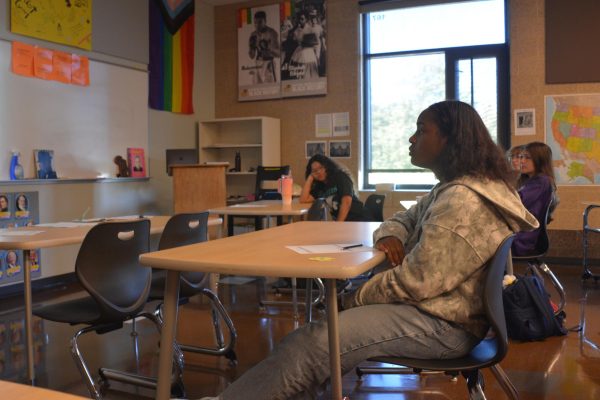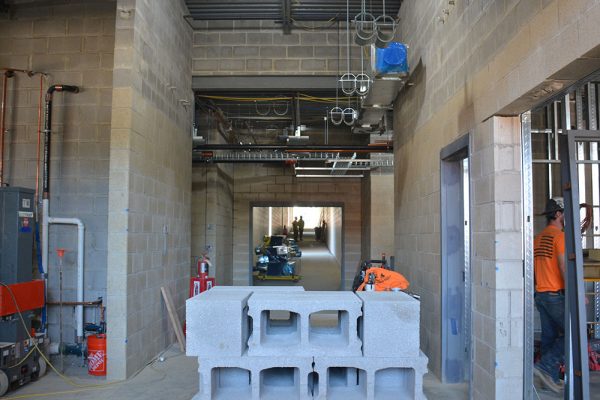Teachers Working Under New Contract This Year
Bradford Douglas / bcomber archives
A school nexus is dependent on two things: a proven connection between the misconduct and the school’s best interest as well as a substantial disruption of school operations.
Beachwood teachers are working under a new contract, effective until Aug. 2022.
The previous three-year teacher contract was ratified in Aug. 2015 and ended Aug. 2018.
Last year, Beachwood teachers worked without a new deal due to the failure of Issue 2, a combined operating and bond levy.
“Our teachers worked under a renewed one year from the previous three-year contract while we continued to negotiate,” Superintendent Dr. Bob Hardis said.
This past summer district administrators negotiated a retroactive contract for the 2018-19 school year with the Beachwood Federation of Teachers (BFT), along with a new contract for the next three years.
The contract includes a 2% raise each year and a new pay scale called Salary Schedule D for newly-hired teachers.
“The district now has a new pay scale that will pay [new and future] teachers less…, but [administrators] wanted it to help [the district] be more financially stable in future years,” BFT President Evan Luzar said.
Salary schedules determine the incomes of employees throughout their careers. With more years of experience and/or advancement in educational degree, teachers can earn an increase in salary, moving them a step down a column or over a row.
According to Hardis, the new salary schedule for new certificated staff was negotiated to reduce the disparity between Beachwood and other districts while still remaining competitive for recruiting.
“We are fiscal stewards of taxpayers’ money,” Hardis said. “We never want our salary to prevent us from recruiting the person we want to hire, [but] we think we could do that without giving that person such a large increase from their current salary.”
As a result, although the starting salary of new Beachwood teachers is ratcheted back, the district’s teachers remain among the highest paid in the state of Ohio.
In 2017-2018, the average teacher starting salary in Ohio was $35,923. According to records from the Ohio State Employment Relations Board, Beachwood’s 2019-2020 Salary Schedule D for new teachers with a BA will have a starting salary of $45,000. A teacher with 35 or more years of teaching experience who has earned a MA degree and an additional 60 graduate credit hours in education coursework will earn $113,000.
Teachers working under Salary Schedule B and C would have a maximum achievable salary of $114,029 after 15 years of experience and $114,805 after 27 years of experience, respectively.
In comparison, Orange City Schools 2019-2020 Salary Schedule shows a base salary of $49,614 and a maximum salary of $112,646 with a PhD and 30+ years of teaching experience. Solon City Schools 2019-2020 Salary Schedule shows a base salary of $45,076 for new teachers with a BA and a maximum of $103,489 for teachers with a MA and 30+ years of teaching experience.
“We felt that by negotiating the new salary schedule, we ensured we would not lose any ability to recruit people, but at the same time not pay raises that were outside the market for teachers in northeast Ohio,” Hardis said.
While changes to health care benefits are not significant, the contract encourages those who use the health care plan to be “comparison shoppers.”
“With every contract, we try to inch a little more toward a health care plan that shifts costs to those who use the healthcare plan more,” Hardis said. “All of us who pay into Beachwood’s health care plan… end up paying more in our rates for health care if people don’t comparison shop.”
“We keep trying to take small measures to battle against the rapid increase in healthcare costs, and that benefits everybody,” he added.
Another difference to the new contract is the revision to language surrounding professional development days.
“We had a common interest with the BFT in seeing change in some of the language that restricted how [professional development] days were used,” Hardis said. “[Both teams] agreed to make them more flexible so that we could utilize them in more creative ways responsive to the needs of the schools.”
Under the last contract, teachers had three professional development days. The new contract changed this to two professional development days and two evening programs.
“Teachers will have two separate evenings that they wouldn’t have before that the administration can use for parent teacher conferences, curriculum nights or whatever they would like,” Luzar said.
Luzar explained that there are two processes involved in establishing a new contract: the negotiating process and the ratification process.
The negotiating process, a long and involved process, includes the BFT’s team and the administration’s team. Each side is allowed six members.
“We each present issues that we would like to address, and we try to come up with language that addresses these issues or solves problems,” Luzar said. “Sometimes we can’t come up with an agreement, and we just drop the issues and the status quo is maintained. Sometimes we’re able to come to an agreement and we create new language or new procedures that are satisfactory to both sides.”
Hardis described the process as transparent and collaborative.
“You just keep hashing things out until you get to a place where everyone agrees, or, at minimum, we trade-off something… You compromise in that way until [both sides feel that they’ve negotiated a fair contract],” he said.
Physical education teacher Mary Deitrick, a member of the BFT team, emphasized the importance of listening when negotiating.
“Being a good listener is a very big part of this process,” she said. “I imparted knowledge when I could, and I listened and gave feedback as much as possible.”
Language Arts teacher Michele Toomey, also a member of the union’s negotiating team, agreed.
“For me, the most important part of this process was the mutual ability of the negotiating members to truly hear the opposing viewpoint, to consider that viewpoint and to return to the table with a compromise,” Toomey wrote in an email.
“It takes an open mind to be able to envision and understand the interests of an opposing party. In our own narratives that group is often the ‘other,’ when in essence we all truly have the same goals,” she added.
Once the negotiating teams arrive at a contract they are comfortable with, the ratification process begins. The union’s negotiating team presents the new deal to the union. Two question and answer sessions are held, and a vote is conducted.
“If the union ratifies [the new contract], then the board votes to approve it. Once that happens, you have a new contract that is enforced for three years,” Luzar said.
A lot of time is spent creating the language of the contract.
“We try to be as clear and explicit as possible when creating new language to avoid future conflict over what the meaning of the language is,” Luzar said.
“One word can affect a contract drastically,” Deitrick added.
Hardis agreed that clear, concise language is important to establishing good contracts.
“When you have a contract that has very clear language in it that everyone understands, that makes a world of difference in terms of the everyday functioning of the organization because people have a clear understanding of what their requirements are [and] have a clear understanding of what their benefits and salary will be,” Hardis said.
“When you have confusion or you have assumptions or people interpreting things in very different ways, oftentimes that leads to conflict,” he added, “and we don’t want conflict because honestly we want all of our energy placed in the students, not in arguing with each other about what a contract article or clause means.”

Vivian Li began writing for the Beachcomber in 2016. She covers various news and feature stories in BHS and the community. In addition to writing for the...










